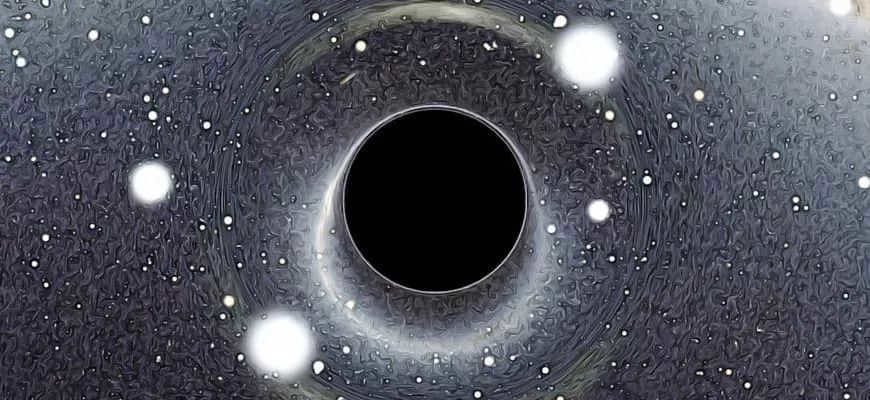
Every well-informed individual is aware of the process through which a classical planetary system originates. It unfolds as follows: a rotating disk composed of gas and dust suddenly begins to contract on its own. Over time, it accumulates a certain density. Within its core, conditions materialize that enable a thermonuclear reaction to occur. During this reaction, hydrogen atoms merge and transform into helium atoms, resulting in an immense release of energy. This is the birth of a new star.
From the remnants left behind after the star’s formation, planets are born. This formation process spans millions of years. And when a star perishes, so do its planets. They either incinerate in their final moments and descend into frigid darkness or succumb to obliteration by a supernova….
But what do you think about this idea – sometimes, life can emerge on a planet… after the demise of a star?
Life beyond death
Envision a world that comes into existence not with the initial rays of a star, but amidst the turmoil of its decaying remains. This world is born amidst the ruins of a once magnificent planetary system, one that thrived for billions of blissful years. However, its time has come to an end, and the star is gradually fading away, becoming invisible amidst the ancient spiral arms of its galaxy…
It’s a melancholy thought. Yet, not only is such a scenario possible, but the very first planet discovered by astronomers outside our solar system fits this description. It is a celestial undead, orbiting a neutron star. And this planet was born following the demise of the preceding planetary system…
Scientists have yet to determine the exact prevalence of such peculiar planets in space. However, it seems that there is a multitude of these worlds, which could potentially be some of the most peculiar and inhospitable places in the entire universe.
Hold on for a moment. Why have astronomers suddenly come to the conclusion that these planets are not merely remnants of a supernova explosion?
The truth is, nothing and no one can survive the catastrophic force of a supernova explosion. No rock formation can withstand the immense shockwave, nor can any advanced civilization create a protective field capable of deflecting the astronomical energy released by our own Sun over the course of 10 billion years, or even a thousand times more! This wave would obliterate everything in its path and instantly annihilate anything it encounters. When a star goes supernova, everything within a few light years of it is eternally condemned….
It is evident that any object circling around a neutron star, the leftover of a supernova, was present before the catastrophic event occurred.
However, is it possible for life to thrive on such a celestial body? And how would life appear on a planet orbiting a neutron star?
Illumination from deceased celestial bodies
The question arises as to whether it would be feasible there in essence. Because the circumstances on such a planet would resemble something akin to a discotheque within the depths of a detonated thermonuclear bomb. In the event that the parent star happens to be a pulsar or magnetar (which are youthful and active versions of neutron stars), they would constantly subject their planets to radiation bombardment. These celestial bodies rotate around their respective centers of mass at mind-boggling velocities. The sky of a planet would be illuminated in a manner reminiscent of a strobe light if the pulsar’s emission were to directly impact it. Alternatively, it would appear as a speck of light the magnitude of a remote extraterrestrial sun, which would flicker multiple times per second….
Regardless, a planet like this would experience a perpetual onslaught of radiation tsunamis. These tsunamis would incessantly sanitize the planet’s surface, dismantle its magnetosphere, and trigger volatile chemical reactions within its remaining atmosphere. The ability to survive in such a post-apocalyptic world would pose an immense challenge. Undoubtedly, sustaining life on such a planet would prove to be (almost!) insurmountable. Additionally, the planet’s surface would be bitterly frigid! The absence of conventional sunlight, which typically provides continuous warmth like our Sun does, would contribute to this chilling environment.
However, there remains a slight chance that such planets might support life. A prime example of such a celestial body is the initial exoplanet ever discovered. This super-Earth orbits a pulsar dubbed PSR B1257+12. It possesses a mass four to five times greater than our own planet and maintains a proximity to the pulsar akin to Earth’s relationship with the Sun. Despite the exoplanet having an atmosphere that is a million times denser than that of Earth, a continual stream of X-rays can generate enough warmth to sustain liquid water. Consequently, life could potentially exist. In the deepest recesses, within the coldest and darkest corners…..
So, we have established that life near a neutron star is theoretically possible. However, what about a black hole? Similar to the scenario depicted in the film Interstellar, could there conceivably be habitable planets in close proximity to a celestial entity that effectively “tears” space and time apart?
Existence in Proximity to Black Holes
As per certain investigations, this phenomenon is indeed plausible, but with several important considerations. The black hole in question must be of a supermassive nature, possessing a size substantial enough to exert its gravitational influence over vast distances. Additionally, it must actively consume gas and dust in order to form an accretion disk that emits both light and heat. Given these circumstances, a planet would need to maintain a distance of approximately ten light-years from the black hole in order to develop normally and sustain life-friendly conditions.
Smaller black holes lack the necessary dimensions and are too frigid to support any type of life within their orbits. Furthermore, venturing too close to a black hole of any magnitude would result in encountering destructive tidal forces that disrupt the very fabric of reality.
In brief, the possibility exists for life to exist on a zombified planet. However, the conditions required for this life would be extraordinarily peculiar and unconventional within the realm of space. Yet, it is precisely their extraordinary nature, in which the familiar is defied and everything is turned upside down, that renders them immensely captivating.
This notion serves as a poignant reminder that reality can surpass the bounds of imagination. Furthermore, it emphasizes that comprehending the universe is not necessarily within our grasp…
Stars come into existence when the internal regions of gas clouds collapse due to the force of gravity, and reach maturity when their core becomes hot enough to sustain nuclear reactions. These reactions convert a portion of the star’s mass into energy.
Stars that are more massive than the Sun become significantly brighter and burn through their fuel much faster. While our Sun can survive for at least 10 billion years, a star that is 20 times more massive will only last about 10 million years. Sun-like stars typically end their lives as slowly cooling white dwarfs. White dwarfs. Stars that are 10 times or more massive than the Sun can explode in a supernova, with the debris scattering across vast distances in space and leaving behind incredibly dense neutron stars at their cores. The most massive stars are likely to collapse into black holes after their cores shrink. Astronomers theorize that when an extremely massive star exhausts its fuel, it begins to infinitely shrink. As the star’s size decreases, the gravitational force on its surface intensifies. Eventually, the star becomes invisible, but its contraction continues until it reaches an unimaginably small size. The gravitational force in the vicinity of this point is so powerful that not even light can escape from it. This region in space is known as a black hole. Many scientists believe that black holes exist at the centers of numerous galaxies.
A star similar to our Sun is created when a cloud of gas starts to contract because of its own gravity. As the cloud compresses, it heats up and begins to emit a faint red light. Once the temperature at its core reaches 10 million degrees Celsius, thermonuclear reactions take place, releasing immense amounts of energy. The star then enters its main sequence phase and remains in this state virtually unchanged for the next 10 billion years. However, at a certain point, the fuel in the core is depleted, causing it to contract and become extremely hot. Hydrogen fusion no longer occurs inside the core, but instead on its outer layers, causing the star to expand and become a red giant that rapidly burns through the remaining fuel. As the star sheds its outer layers, it forms an expanding shell known as a planetary nebula. One example of such a nebula is the Ring Nebula. From the core, a white dwarf is born. Over the following billion years, it cools down and fades away, eventually transforming into a cold black dwarf.
This luminous gas cloud is located 1,600 light years from Earth, positioned below a trio of stars in the famous constellation Orion’s belt. The mesmerizing glow emitted by this cloud is a result of its composition, which includes a multitude of vibrant young stars. In addition to this fascinating revelation, infrared observations have unveiled the presence of numerous stars that are currently in the process of formation.
Supernova: the awe-inspiring detonation of a celestial body
In the heart of a star, which is much more massive than our Sun, a variety of nuclear reactions can occur, resulting in the creation of an iron core. Once this occurs, the core is depleted of all available energy sources. As a result, the core collapses and a neutron star is born. The outer layers of the star then collapse onto the core, triggering a powerful explosion that hurls most of the star’s material into space at speeds exceeding 8 thousand km/sec. In 1054, Chinese astronomers witnessed the explosion of a supernova, and today we can observe the scattered remnants of this event in the form of the Crab Nebula in the constellation Taurus.
Neutron stars rotate at a rapid pace, emitting electromagnetic waves into the vastness of space in the form of a remarkably narrow beam. Whenever this beam aligns with Earth, we witness a brilliant burst, reminiscent of the signals emitted by a lighthouse. In order to counterbalance the immense power of the Sun, twelve brown dwarfs, which possess the lowest mass among all stars, must be precisely positioned on the opposite side of the cosmic scale. Furthermore, it would require the combined mass of one hundred suns to stabilize the most massive star known to us. Astonishingly, a mere sugar cube-sized fragment of white dwarf material would weigh as much as an entire automobile. In comparison, a cube of matter from a neutron star would tip the scales at the weight of a small mountain. It is fascinating to note that there are numerous stars whose luminosity varies over time. These variable stars, such as Cepheids, are aging celestial bodies that undergo periodic expansion and contraction, resulting in corresponding changes in their luminosity and temperature. Interestingly, the duration of these luminosity fluctuations is longer for larger and more brilliant Cepheids, while smaller Cepheids with less mass and luminosity experience shorter periods of change.
The power of the dark abyss
The gravitational strength intensifies significantly near the edge of a black hole. The tip of a spacecraft as it nears the black hole is pulled towards its center, and the spacecraft itself is elongated. The force responsible for this phenomenon is referred to as tidal force, and it grows rapidly, eventually causing the spacecraft to be crushed. A person observing this occurrence from a considerable distance will witness a remarkable occurrence: time aboard the ship will slow down as it gets closer to the black hole. The diagram displays the duration of each stage in seconds, with the top representing the observer’s perspective and the bottom indicating the time on board the spacecraft. From the observer’s standpoint, the descent of the spacecraft into the black hole seems to take an eternity.
Swan X-1
Swan X-1 is an astronomical phenomenon that emits X-ray radiation and is observed on Earth. It is composed of a star with a mass equivalent to 20 suns and a dark entity with a mass approximately 10 times that of the sun. These two objects orbit each other in a complete revolution every 5.6 days. Many scientists in the field of astronomy hypothesize that the dark object is a black hole, which gradually extracts matter from the star to create an accretion disk. The central region of this disk is incredibly hot and emits X-rays.
If the Earth were to undergo a collapse similar to that of a collapsing star, it would reduce in size to the dimensions of the black circle depicted here. However, this scenario is scientifically implausible, as astronomers firmly believe that only bodies with a mass exceeding three solar masses have the potential to transform into black holes.
The Empire had created a fearsome weapon known as the Death Star, a colossal space station equipped with a planet-destroying weapon. The purpose of this ominous creation was to instill fear in the rebels and gain control over planets by threatening their annihilation. However, despite showcasing the Empire’s power and cruelty, the Death Star was ultimately a manifestation of its fatal flaw – an unwavering belief in the dominance of terror and technology over the fight for liberty. In the end, the Rebel Alliance successfully brought down both the original Death Star and its successor.
Characterization in a Nutshell
The station’s immense size necessitated a substantial financial commitment and a significant human workforce.
At any given time, approximately 1,700,000 crew members and 400,000 droids were tirelessly laboring on the station, dedicated to upholding the Empire’s grandeur.
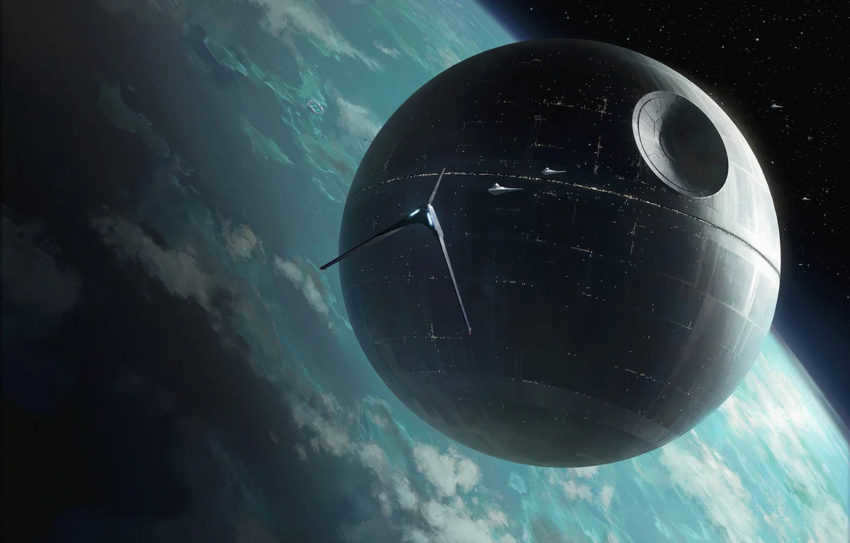
There were numerous star destroyers and countless regular spaceships docked at the Death Star.
This station was essentially a man-made planet with massive weaponry and defenses.
Considering the station’s crew numbered in the approximate population of a medium-sized city, provisions, parks, recreational facilities, and more were created for their benefit. In summary, living there was not a hardship.
Origin of the Station
The station was originally created by the Jeonesians as a formidable weapon designed to annihilate the Republic. Once completed, it was entrusted to Count Dooku, who later handed it over to Darth Sidious.
Palpatine, upon assuming power, issued the directive to construct the Death Star. The station underwent continuous development throughout the Clone Wars. Following the collapse of the Republic and the rise of the Empire, substantial financial resources were allocated to expedite its completion. However, the fledgling regime encountered logistical challenges that prolonged the construction period to a staggering 19 years.
The Empire depleted nearly all of its available resources in the pursuit of completing the station, which finally came to fruition after two decades.
Regrettably, the station’s reign of galactic supremacy proved to be transient.
In the Battle of Yavin, at 0 DBYA, a group of rebels launched an assault on the Death Star. Luke Skywalker, the sole remaining pilot, was guided by the Force as he skillfully aimed and launched projectiles at the target, resulting in the destruction of the massive station.
The initial Death Star
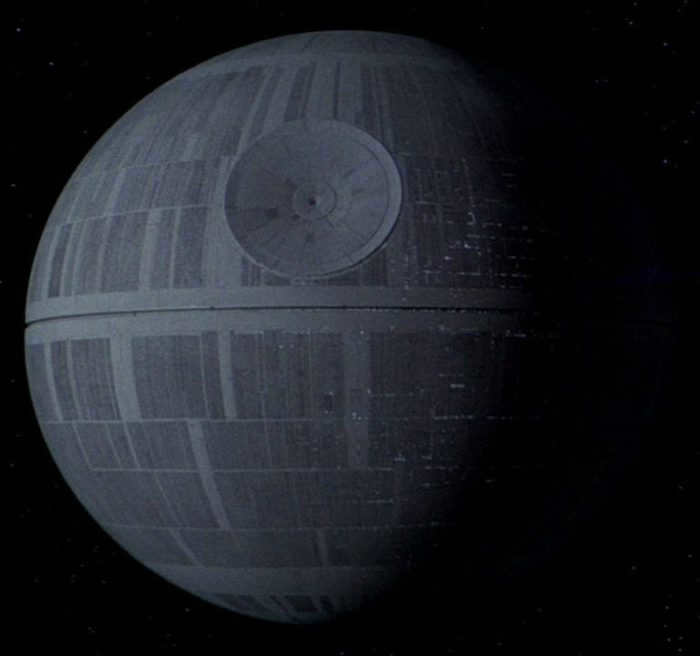

The majority of the occurrences portrayed in this segment are shown in Star Wars: Episode IV. A New Hope.
“The Death Star was conceptualized prior to the Clone Wars (with the Separatists intending to employ it against the Republic), but its construction was thwarted by the invasion of Geonosis. The blueprints of this formidable weapon fell into the hands of Darth Sidious, who saw an opportunity to utilize them upon assuming the role of Emperor. Eventually, the Death Star was entrusted to the Empire, specifically to Wright Synar and Bevel Lemelisk, at the request of Grand Moff Tarkin, who sought to exert control over the Outer Territories. Initially, the Death Star’s purpose was to obliterate lifeless planets in order to streamline mining operations. However, Tarkin had a different agenda – he aimed to instill fear in the inhabitants of sectors under his command and eradicate any potential resistance to the Imperial reign. To accomplish this, Sinar harnessed the Geonosis “Great Weapon” project which had been initiated prior to the Clone Wars. The construction of the Death Star was eventually completed in the year of the Battle of Yavin.”
Tarkin was excited to test out the new weapon. Darth Vader apprehended Princess Leia, a Rebel operative, who had stolen the Death Star plans but had managed to conceal them, and brought her on board the station. With the Rebel Alliance gaining popularity, the Empire was desperate to put a stop to their progress, especially since they could potentially exploit a vulnerability in the plans and destroy the station. Vader attempted to extract information from Leia by using a robotic baton to inflict pain, hoping she would reveal the location of the secret Rebel base and disclose the whereabouts of the plans. However, she remained steadfast and refused to give in. Tarkin transported the Death Star to Alderaan, Leia’s home planet, and warned her that if she didn’t divulge the rebel base, he would obliterate Alderaan. In a state of panic, Leia falsely claimed that the base was located on the remote planet of Dantooine. Despite this, Tarkin proceeded with the destruction of Alderaan, as he sought to teach the rebels a lesson and believed that annihilating a heavily populated planet at the heart of the galaxy, which provided support to the rebels, would serve as a powerful deterrent.
Leia concealed the plans of the Star in the astromech droid R2-D2 and instructed him to locate Obi-Wan Kenobi. Obi-Wan, accompanied by Luke Skywalker, Han Solo, Chewbacca, and the robotic translator C3PO, eventually arrived at Death Star dock 2037 on board the Millennium Falcon spacecraft, which was ensnared by the Star’s gravitational beam shortly after making a hyperjump to the now non-existent Alderaan.
Shortly after, Leia was rescued by Luke Skywalker and Han Solo, but their ship was marked with a signal that alerted the Imperial forces to the location of the Rebel base on the fourth satellite of Yavin. “The Death Star was sent there to deliver a devastating blow to the Alliance. In the meantime, the Rebels analyzed the plans stolen by Leia and discovered that the only way to destroy the heavily fortified station was to target its main reactor through an exhaust vent that ended in a small opening of approximately two meters in diameter. When the Death Star arrived in the Yavin system, it was met with resistance from rebel fighter units. Thus began the Battle of Yavin, a historic event that marked the beginning of the New Republic. The Rebels suffered significant losses, but before the Death Star could position itself for an attack, Luke Skywalker successfully hit the station’s reactor with a proton missile (torpedo), causing the Death Star to explode. Tarkin, the mastermind behind the Death Star, perished, and Vader, who was defending the station, was thrown into space by Han Solo’s precise shot. This victory allowed the Alliance to strengthen its position, although the Empire was far from being defeated.
Enraged by the downfall of the station, Emperor Palpatine punished Lemelisk, whom he held personally accountable for the failure, with a torturous demise. Prior to this, a duplicate of Lemelisk had been cultivated and (using Sith techniques to transfer the designer’s essence into him) was compelled to create a fresh, even larger Death Star that would be free from the flaws of its predecessor. Occasionally, Palpatine would once again execute Lemelisk and bring his clone back into existence.
The Death Star II
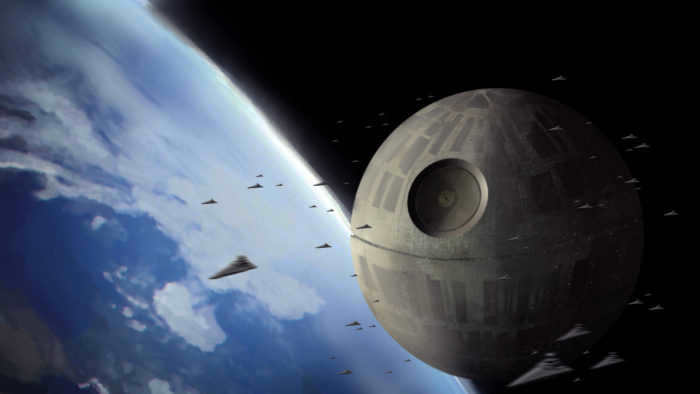

The majority of the incidents outlined in this segment are depicted in Star Wars: Episode VI. The Return of the Jedi.
The latest iteration of the Death Star boasts enhanced power and impenetrability compared to its predecessor. Rather than relying on a vulnerable ventilation shaft, the new design features an intricate network of pipes that are equipped with millions of tiny openings, each with a fuse to prevent explosions. The reactor has been upgraded to rapidly accumulate energy, enabling the Death Star to fire a shot in a matter of minutes instead of the previous day-long process. Moreover, the focusing mechanism now allows the beam to be directed not only at planets but also at large spacecraft. To further fortify its defenses, the Death Star is shielded by a force field generated from a location outside the Star, while thousands of laser cannons are positioned throughout its surface. Additionally, the battle station includes hangars for shuttles and fighters.
Emperor Palpatine had a clever strategy in mind – he wanted to make the Rebel Alliance believe that the Star was vulnerable. However, in order to achieve this, they needed to locate and disable the force field generator. The Alliance scouts gathered valuable data, putting their lives at risk, and discovered that the generator was on the forest moon of Endor. Surprisingly, it was poorly guarded. Little did they know, the leak of this information was actually a trap set up by the Emperor. Han Solo and his Rebel squad fell right into it on Endor. The Emperor’s ultimate goal was to lure and annihilate the entire Rebel fleet, which would be sent as a distraction from the main attack. But the heroes, with their ingenuity and a stroke of luck, not only managed to escape the Imperial trap but also succeeded in destroying the generator. The Ewoks, the inhabitants of Endor who resembled small bears, played a crucial role in assisting the heroes. They helped turn the tide in their favor. Following that, Lando Calrissian led a squadron of Alliance fighters, piloting the Millennium Falcon, and sneaked into the reactor through the ventilation system (as the Star was still incomplete). They successfully destroyed it and narrowly escaped the ensuing explosion.
“The Gemini Death Stars.”
The construction of the Gemini commenced shortly prior to the Emperor’s demise on Endor. The Twins were a pair of compact battle stations, each measuring approximately 13 kilometers in diameter, yet armed with super lasers of planet-obliterating capability. The construction initiative took place in the vicinity of Coruscant’s orbit. Media outlets disseminated reports that the two celestial spheres in orbit were to serve as future residential settlements for the overpopulated Imperial City.
The destiny of both stations remains a mystery.
The Tarkin battle station
The Tarkin battle station, also known as Tarkin Station, was constructed on the planet Hokoleleg following the Battle of Hoth. In an effort to cut costs, the new Imperial installation deviated from its previous circular design. Instead, it was modeled after the Super Star Destroyer, albeit in a scaled-down version to match the size of the original Death Star. To compensate for its reduced firepower and limited mobility, the station was accompanied by a formidable Imperial fleet, rendering it virtually impregnable. Notably, the ventilation shafts, notorious weak points of Imperial stations, underwent a complete redesign, featuring hundreds of minuscule apertures no larger than two centimeters in diameter. Furthermore, the Tarkin battle station boasted superweapons that were identical in functionality to those found on the first Death Star.
Despite all efforts, the station met its demise. Rebel insurgents managed to infiltrate the station with the intention of obliterating it. However, their plans were foiled by the intervention of Dark Lord Vader, who happened to be present on the station. Engaging in a fierce battle with Luke Skywalker, Vader emerged victorious. Meanwhile, Chubbaka successfully disabled the station’s attraction beams and reconfigured the firing trajectory to target the station itself. Vader swiftly pursued the Rebels in his DI Fighter, while the station prepared to unleash its destructive power. As a consequence of the ensuing onslaught, the station was utterly shattered.
In Timothy Zahn’s book The Last Order, it is mentioned that there existed a Tarkin-2 battle station within the New Republic. This station, which was three times larger than the Death Star, lacked a superlaser but made up for it with double the number of weapons and a stronger shield. The station was named after Grand Moffat as a tribute to his bravery in not abandoning the Death Star during its crash.
Specifications for Technical Equipment
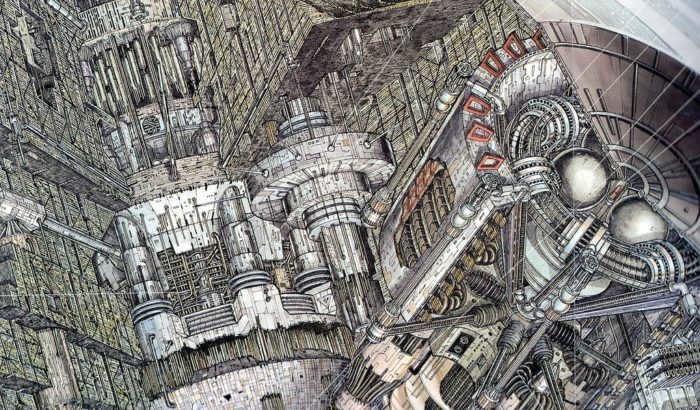
- The initial station has a diameter of 164 kilometers. The second star, however, has a diameter of 900 kilometers. Previous sources provided smaller measurements. To provide some context, the Moon has a diameter of approximately 3480 km.
- There are 2 hyperspace engines
- For each navigation bank of the hyperjump system, there are 123 generators symmetrically located on the surface of the station.
- There are also 2 travel engines
Full-time crew
- The total number of officers is 27,048
- There are 774,576 soldiers, pilots, and mechanics
- The maintenance personnel range from 378,576 to 378,685
- Approximately 25,000 stormtroopers serve as Imperial Guards
- There are approximately 400,000 various droids
Armament
- The Death Star is equipped with a central guiding superlaser that is super-powered. The first station has a firing rate of 1 shot in 24 hours, while the second station can fire 1 shot in 3 minutes
- There are 8 high-precision super lasers
- The Death Star has 5,000 laser batteries
- There are also 5,000 heavy laser batteries
- 2,500 laser cannons are installed on the Death Star
- Additionally, there are 2,500 ion cannons
- 768 capture beam generators/projectors are part of the Death Star’s armament
Spaceships on board
- There are 4 main class ships;
- Also, there are 7,200 LED fighters;
- Along with 3600 L-class shuttles;
- Additionally, there are 1,860 landing craft;
- Moreover, there are 13,000 planetary vehicles and additional fleets:
- Furthermore, there are 1,400 ATV tanks;
- There are also 1,400 AST self-propelled vehicles;
- In addition, there are 178 commander tanks;
- Moreover, there are 356 “flying fortresses”;
- Also, there are 4,843 HAVwAS heavy wheeled tanks;
- There are 4,824 Auxiliary Fleet units;
- In addition, there are 300 TIE fighters;
- Also, there are 5 of Darth Vader’s personal TIE fighters;
Impact
On December 14, 2012, an idea was presented to construct a functional Death Star within the borders of the United States with the intention of enhancing the nation’s defense capabilities and stimulating job growth. The proposition has garnered a significant amount of support, accumulating over 26,000 signatures. However, the administration under Barack Obama has officially declined to explore potential avenues for implementing the program. Paul Shawcross, the director of science and space at the White House Office of Management and Budget, has outlined the rationales behind this decision:
- “The construction of the Death Star would require an astronomical sum of 850 quadrillion dollars, which contradicts our current efforts to reduce the budget deficit rather than exacerbate it.”
- “The President’s administration is firmly opposed to the notion of annihilating planets or exerting control over nations.”
- “Why waste such a massive amount of taxpayer funds on a Death Star that possesses a fundamental flaw – it can be obliterated by a single individual?”
In 2009, Rishard Gold conducted a rough estimate of the expense and timeline required to construct the Death Star given the current circumstances, resulting in a staggering cost of 15.6 septillion (1.56 – 1026) US dollars.
During the early days of February 2013, an initiative emerged on the Kickstarter platform with the aim of securing financial support from online users to bring the Death Star into existence.
From certain perspectives, the “Death Star” bears a resemblance to Saturn’s moon Mimas, primarily due to the Herschel crater occupying a significant portion of its surface. Interestingly, the initial images capturing the crater were taken three years subsequent to the release of the first Death Star movie.
The movement of the Death Star
The Death Star seems to have a slow and self-rotating motion, with a seemingly invisible force propelling it forward. It cleverly avoids engaging in direct confrontation by positioning itself in front of its target, causing any opposing force to collide with its weapon instead of approaching from the opposite direction (although this is primarily for visual and aesthetic purposes, of course).
Vulnerability
Similar to how B – B is a devastating blow against an opposing force, its size also makes it vulnerable. While Ion torpedoes can pierce the top shell and cause internal damage, they have limited impact if not aimed properly due to the immense scale of the station.
The initial Death Star was destroyed because it had a small exhaust port that connected the upper shell to the main reactor, and missiles were able to be directly delivered into it. The weakness of the second Death Star was its incomplete super-passage, which provided a clear path for Rebellion craft to reach its reactor core and fire directly into it. This became possible once the shield on Endor was closed, granting access to the interior.
Death Star appearances in films
- In the film Star Wars: Episode II – Attack of the Clones, the Death Star only appears as a hologram.
- In the film Star Wars: Episode III – Revenge of the Sith, the Death Star is shown as unfinished.
- In the film Outcast One: Star Wars – The Stories, the Death Star is featured.
- In the film Star Wars: Episode IV – A New Hope, the Death Star plays a major role.
- In the film Star Wars: Episode VI – Return of the Jedi, the Death Star makes a significant appearance.
- In the film Star Wars: Episode VII – The Force Awakens, the Death Star is again shown as a hologram.
- In the film Star Wars: Episode IX – Skywalker. Rise, the Death Star is seen in debris form.
Death Star Comparisons
- The Death Star in the BBMMORPG game Ogame is considered the most formidable ship, boasting unparalleled defense and immense offensive capabilities. In the game, the “Death Star” is equipped with a graviton cannon that has the ability to obliterate moons. Interestingly, in the initial version of the game’s visual design, the Death Star bore a striking resemblance to the iconic ship from “Star Wars”. However, the design has since been updated, leaving only the name as a nod to the original.
- In the animated series Magic Parents, the antagonist Dark Leizer possesses a Death Ball, which serves as a comical parody of the Death Star.
- Dr. Eggman, the primary antagonist in the Sonic the Hedgehog game series, has on multiple occasions constructed a space station known as the Death Egg, drawing inspiration from the Death Star.
- “The Death Star in the online turn-based strategy game Divide&Conquer weighs a massive 40,000 tons and was the heaviest unit in the game until it was rebalanced in March 2009. Unlike its counterparts in other fictional universes, it is not capable of destroying planets and is specifically designed for orbital combat. Many players are dissatisfied with its appearance, as it closely resembles the ship from Star Wars, which is not consistent with the game’s design. The name of the unit also receives complaints, as it does not align with the spirit of the game or the functions of the prototype.”
- The Imperial destroyer with a Super Laser is based on the Vogon ship from Douglas Adams’ famous novel The Hitchhiker’s Guide to the Galaxy and its 2005 film adaptation.
- In the Babylon 5 television series, the Vorlon race possesses a formidable fleet of enormous spacecraft known as Planet Destroyers, capable of obliterating whole planets with just one salvo from their weapons.
- In the Galactic Civilizations video games, particularly malevolent civilizations have the ability to upgrade a regular space station into a fearsome Terror Star. The destructive power of the Terror Star surpasses that of the Death Star, as it can annihilate an entire star system, transforming the star itself into a brand new one.
- In the game Master of Orion 2, the most formidable class of spaceship is the Doom Star. Additionally, there is also the Stellar Converter weapon, which holds the capability to eradicate an entire planet, transforming it into a ring of asteroids.
- In Descent: FreeSpace, the SD (Shivan Destroyer) known as “Lucifer” serves as the equivalent of a death star, possessing formidable defenses that make it impervious to external attacks and can only be destroyed in subspace. The game’s sequel, FreeSpace 2, introduces even larger Shivan vessels such as the SJ (Shivan Juggernaut) of the Satan class, capable of obliterating an entire star system.
- The TV series Lexx showcases a bug ship, a living organism referred to as “the most destructive force in two universes.” This formidable vessel possesses the capability to annihilate any celestial body, including a neutron star, with a single devastating salvo.
- Unicron, prominently featured in the feature-length animated film Transformers – The movie, is a colossal robot capable of transforming into a planet.
- The main antagonist in the animated series “Planet of the Monsters” is a group of unidentified entities who possess a colossal spherical spacecraft capable of engulfing an entire planet.
- In Fritz Leiber’s novel “The Wanderer,” there are formidable battle stations that exceed the size of the Death Star. These stations are constructed using planets that are comparable in size to Earth, if not slightly larger. The crew aboard these stations consists of the entire population of the respective planets, numbering in the billions.
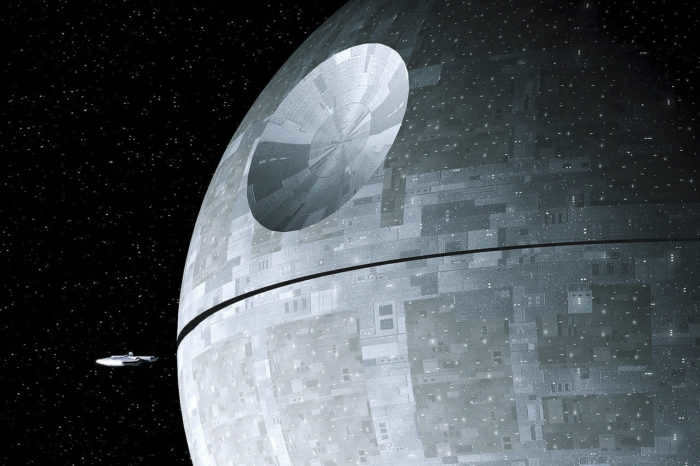
Mimas, a moon of Saturn with a diameter of 185 km, was captured on camera three years after the release of the film.
- The Stargate Enclave of the Gri civilization claims to have a connection to a Stargate.
- Mimas, a moon of Saturn, bears a resemblance to the Death Star.
- As of September 2011, the Death Star was valued at $15,602,022,489,829,821,821,422,422,840,840,226.94, but it would take 833,315 years to mine the required amount of steel.
- In early December 2012, a proposal was put forward in the United States to construct a real-life “Death Star” in order to bolster the country’s defense capabilities and generate new employment opportunities. The petition garnered several thousand signatures.
6 fascinating facts about the Death Star that only the most devoted Star Wars enthusiasts are aware of
Just how massive was the iconic Death Star from the original Star Wars trilogy? And what would be the actual cost of constructing such a formidable station?
6. Magnitude and proportions
The initial Death Star boasted a diameter of 160 kilometers and contained an astonishing 357 internal levels. It truly showcased remarkable engineering and, if not for the heroic efforts of the resistance army, could have become the ultimate emblem of galactic oppression.
The next iteration of the fearsome battle station was significantly bigger, measuring 200 kilometers in diameter and featuring a staggering 560 internal levels. There is a strong possibility that the Empire had already begun devising blueprints for even larger battle stations as their research and development efforts persisted. Thankfully, the resistance was able to thwart their plans, averting a potentially catastrophic outcome.
5. External Coverage
Quadanium steel, a durable metal sourced from Despire, was utilized in the construction of both Death Stars. The Empire also employed Quadanium for defense in certain models of SID fighters and other ships.
Interestingly, the initial Death Star’s primary construction occurred on Despire following its relocation from Geonosis at the conclusion of The Clone Wars.
4- Weapons
Darth Sirius utilized cyber crystals, the same materials that powered his lightsabers, to construct the primary weapon of the Death Star, a weapon capable of obliterating entire planets. These minerals, which were attuned to the Force, possessed unique properties that allowed lightsabers to possess an incredibly formidable cutting ability. The cyber crystals were connected to a hypermatter-destroying reactor, which was fueled by the same substance used to power the hyperdrives.
The Empire scoured the galaxy in search of cyber crystals, causing devastation to numerous planets. Although the specific number of crystals is unknown, the fact that two fully operational super lasers were constructed for the Death Stars is a testament to their abundance.
3. The enhanced superlaser of the second Death Star
Following the destruction of the initial Death Star, the Emperor wasted no time in commencing the construction of an upgraded iteration of the battle station, which not only rectified the design flaws but also enhanced the superlaser.
This newly improved laser boasted the ability to rapidly cool down and recharge for subsequent shots within minutes, as opposed to the hours it took for the previous version. Furthermore, its beam had the capability to taper and track substantially smaller targets, including large ships, thus transforming the second Death Star into a versatile battle station rather than merely a planet-obliterating weapon.
2. The Natural Pull of Gravity in the Death Star
Despite the fact that the Death Star’s internal gravity was artificially created, its immense size also resulted in a natural gravitational force. As a result, the designers had to take into account various factors that would impact its orbit, hyperdrive capabilities, and troop deployment.
Interestingly, the LED fighters had to depart from the Death Star in a manner similar to how they would leave the atmosphere of an actual planet. This places the battle station in the same category as objects found in the real world, such as large asteroids and planetoids, which possess their own gravitational pull.
1. The Price of an Authentic Death Star
In reality, the expenses for large-scale construction projects are projected to reach billions of dollars, which pales in comparison to the trillions that make up the world economy. However, these figures are minuscule when considering the astronomical cost of constructing and maintaining a genuine Death Star.
According to calculations by Forbes, the construction of such a colossal battle station alone would require a staggering $852 quadrillion. Furthermore, British energy supplier Ovo has estimated that the daily operational expenses for a functioning Death Star would amount to an astonishing $7.8 octillion. Truly remarkable figures, aren’t they?
What is the knowledge we have about Mimas?
Mimas is a moon of Saturn that is known for its small size. With an average radius of less than 198 kilometers, it is one of the smallest moons in the Saturn system. Due to its size, Mimas does not have a perfectly spherical shape and instead has an ellipsoid shape. Its dimensions are approximately 207×197×191 km. Scientists have determined that Mimas is a low-density object, leading them to believe that it is primarily composed of water ice. In fact, Mimas is the only known celestial body to have water ice as its main constituent.
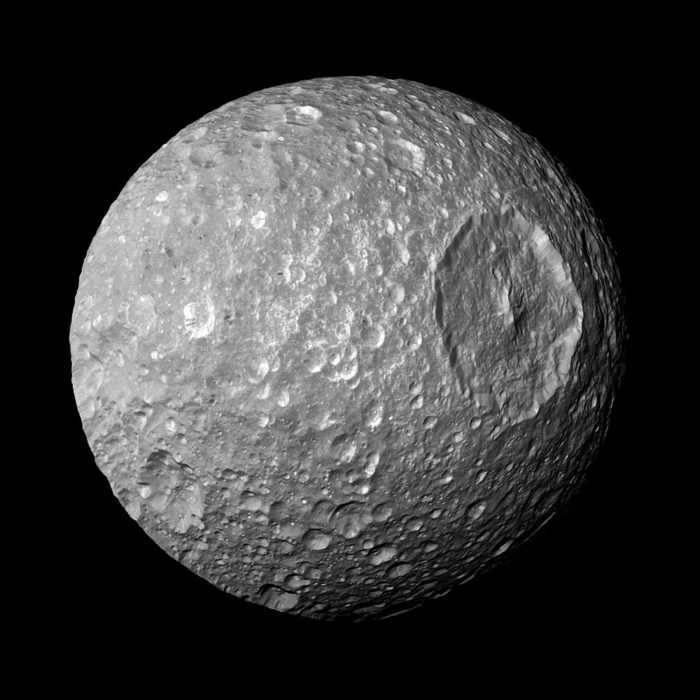

The Death Star, as depicted in the Star Wars movies, is a fictional space station capable of destroying entire planets. However, could such a massive structure be built in reality?
Mimas, one of Saturn’s moons, orbits the planet at an average distance of approximately 186,000 km. It completes a full orbit in just 22 hours and 36 minutes. Interestingly, Mimas always faces the same side towards Saturn, much like how the Moon always faces the same side towards Earth.
The surface of Mimas is primarily covered with impact craters, many of which are more than 40 kilometers in diameter. However, at the moon’s South Pole, these craters are only about 20 kilometers in diameter. This suggests that certain geological processes, such as melting, may have occurred there at a later time compared to the rest of the moon.
The Death Star
The most notable characteristic of Mimas is its enormous impact crater called Herschel (named after the moon’s discoverer). Due to its striking resemblance to the iconic battle space station from the Star Wars universe, this satellite has been affectionately referred to as the Death Star. The Herschel crater is particularly impressive in terms of its size, measuring over 130 km in diameter, which is approximately one-third the size of the moon itself.

The outer walls of the Death Star, featured in the Star Wars movie, reach an impressive height of approximately 5 kilometers. The force of the impact that created the crater on Mimas, one of Saturn’s moons, was so powerful that it could have potentially shattered the moon if it had been slightly more intense.
A great enigma of Mimas
Another perplexing aspect of Saturn’s moon is its frozen state, despite its closer proximity to Saturn compared to Enceladus. Additionally, Mimas possesses a significantly more elliptical (elongated) orbit than Saturn’s other moon. These peculiarities suggest that Mimas experiences tidal heating that is significantly more intense than that of its neighboring moon. Nevertheless, Enceladus displays geysers of water, indicating internal processes that warm the water within the satellite. In contrast, Mimas is characterized by its icy surface.
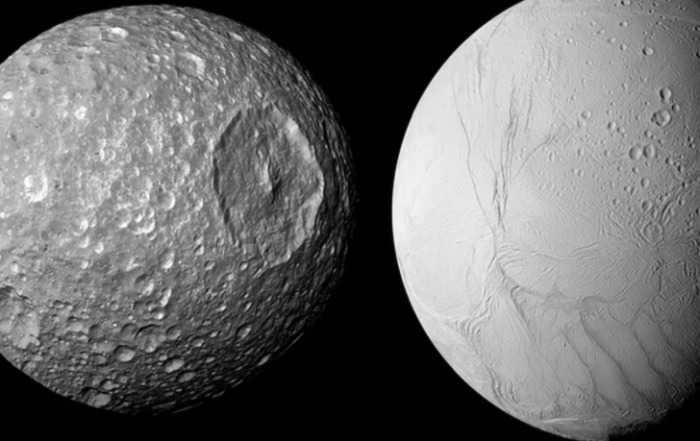
The question of whether the Death Star from the Star Wars movie can be built in reality remains a topic of debate. This issue has given rise to the “Mimas Test,” which requires any theory that explains the partially melted water on Enceladus to also account for the completely frozen water on Mimas. Researchers have recently made progress in unraveling the mystery surrounding Mimas, which is Saturn’s most peculiar moon.
A concealed body of water
Discoveries made during the years 2014-2015 by NASA’s Cassini spacecraft have long suggested to researchers that Mimas might possess a subterranean water source. Nonetheless, experts have never obtained direct verification of this phenomenon. Now, American scientists have conducted an investigation in which they have determined that Mimas could be harboring an imperceptible ocean of liquid water. This implies the potential existence of primitive life forms. Up to this point, scientists have not discovered any evidence of water seeping through the icy surface. Currently, their conclusions regarding the presence of the ocean are solely founded upon numerical modeling.
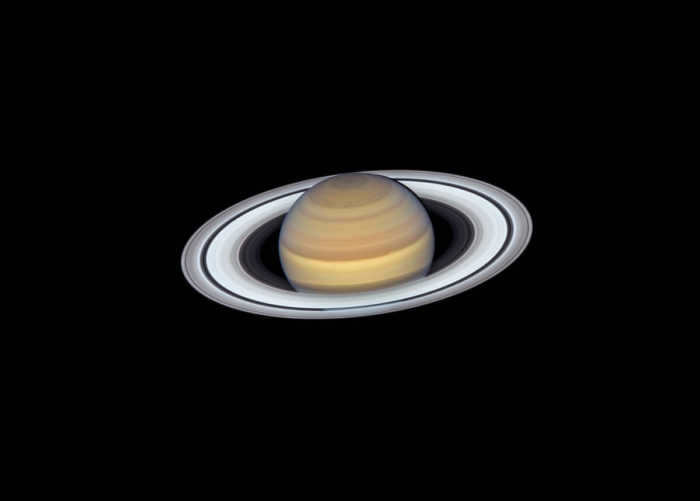
A recent research project examined the phenomenon of tidal heating, a result of the gravitational pull of Saturn. The scientists took into consideration the slight elongation of Mimas’ orbit and the moon’s own wobbling. The findings suggest that this process could lead to the melting of the ice within Mimas.
Researchers have discovered that the depth of the ocean ranges from 24 to 31 kilometers. This measurement can vary based on factors such as the consistency and flexibility of the ice, the surface temperature, and the distribution of heat flow. Interestingly enough, this depth is also significant enough to prevent water geysers from breaking through the surface of the moon, similar to what happens on other moons with theoretical underwater oceans, like Enceladus.
What is the final conclusion?
The Cassini mission has revolutionized our understanding of potential extraterrestrial life. Not only Mars, but also the moons of outer planets like Enceladus, Europa, and Titan are now being considered as potential habitats for life. If the existence of an ocean on Mimas is confirmed, it will completely reshape our knowledge of Saturn.
Subscribe to the UFO WORLD telegram channel
Get immediate notifications of new Articles on your phone
Do not be deceived into thinking that space will remain a peaceful realm indefinitely. The reality is quite different.
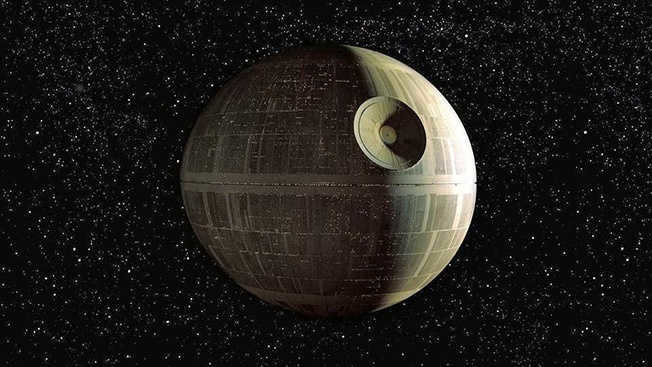
The topic of space militarization gained significant attention in the global media when it was first brought up by U.S. President Ronald Reagan in his announcement of the Strategic Defense Initiative (SDI) program. This announcement sparked a costly arms race between the USSR and the United States, but the concept of space militarization was soon forgotten after the events of 1991.
Origins of the “military space” era
1991 is widely regarded by Americans as the year that marked the end of the race and a triumph over the USSR. The fall of the USSR had a devastating impact on the cutting-edge sectors of our industry, including those involved in space programs, both civilian and military. It appeared that all the invaluable experience and scientific and technological advancements in the field of military space development would never find utility. However, amidst the disintegration of the superpower in 1992, the Russian Federation established the Military Space Forces.
Obviously, the Americans didn’t pay much attention to this event because they already had the Air Force Space Command (AFSPC) established in 1982, which was responsible for launching and operating military satellites for the Pentagon’s needs, including reconnaissance, communications, and missile warning systems. Similarly, our new military branch was also created for similar purposes – to launch and control military satellite systems.
Therefore, since 1992, the term “military space” has become widely recognized as a definition for all military space programs in Russia, the United States, China, and other countries that developed such satellites.
The lack of response from the United States to the establishment of a new type of military force was linked to a shift in the country’s National Military Strategy. The strategy transitioned from containing the Soviet Union to adopting a policy of selectively and flexibly engaging in regional conflicts (referred to as the “Strategy of Flexible and Selective Engagement” in 1992). As a result of this new approach, the U.S. military underwent reductions in both weaponry and military units. The AFSPC programs also experienced funding cuts, although this was only a temporary occurrence due to the necessity of the U.S. military to adjust its programs. It was during this time that global processes began to emerge, which had the potential to disrupt the stability of the unipolar world – also known as Pax Americana.
Global Instant Strike Strategy
In 2002, the U.S. Air Force commissioned the RAND research corporation to publish a report titled “Space Weapons – Earth Wars”. This report acknowledged that the development of space weapons was inevitable and advised the U.S. leadership to establish a policy regarding the militarization of space. Unlike “Ronald Reagan’s Star Wars” initiative, the new approach called for the deployment of actual weapon systems with defined combat objectives in the vacuum of space.
The report from RAND experts highlighted different types of space weapons:
1. Space lasers, also known as directed energy weapons, have high power and advanced optics that enable them to destroy enemy missiles or targets on Earth at the speed of light.
2. Kinetic weapons are designed to intercept missiles and can destroy targets in space or in the Earth’s upper atmosphere through ramming strikes.
3. Space-based kinetic weapons are intended for engaging targets on the Earth’s surface, such as large ships, structures, or fuel tanks. These weapons travel at speeds comparable to meteorites and can strike targets on steep or nearly steep trajectories.
4. Conventional space-based weapons have the ability to maneuver and engage ground targets. They can also utilize unconventional ammunition, such as radio-frequency or microwave weapons.
These weapon systems were designed to enhance the existing satellite network, which includes reconnaissance, communications, and relay satellites, all of which serve the interests of the Pentagon.
The Pentagon commanders and the political parties in the U.S. Congress greatly valued the report. It can be argued that this analytical document had an impact on the U.S. decision to withdraw from the ABM Treaty. This is because the expansion of missile defense zones and the development of new complexes are crucial components of the “Global Instant Strike” strategy, which emerged a year later and prompted the restructuring of the U.S. Armed Forces.
Naturally, the ability of missile defense systems to execute a prompt attack anywhere on the globe within an hour is unattainable, and intercontinental ballistic missiles (ICBMs) would require 3-4 times more time. As a result, the Pentagon required systems that could arrive at a specified location the moment the order to attack was issued. Naturally, this discussion revolved around spacecraft; however, the Earth’s orbit at specific altitudes is already overcrowded not only with satellites from various nations but also with space debris – the remnants of satellites that have ceased to function in their orbits for various reasons. The widespread deployment of military satellites may elicit reactions and unnecessary inquiries, but if executed systematically and within the confines of the law, many vigilant opponents will have no grounds for objection.
Revitalizing America’s Greatness: The Next Frontier
A groundbreaking moment took place in recent history when the United States unveiled its ambitious plans for space exploration. It all began in 2010 with the release of the National Space Policy, which set the stage for a new era of American dominance beyond Earth’s atmosphere. Building upon this foundation, the U.S. Department of Defense Directive #31000.10, aptly named “Space Policy,” emerged two years later, followed by the U.S. Army Chiefs of Staff Manual “Space Operations” a year after that.
Fast forward to June 30, 2017, when the U.S. President made a historic move by signing an executive order to reestablish the National Space Council (NSC). The NSC, originally established in 1989 and disbanded in 1993, had the crucial mission of formulating a cohesive U.S. space policy and developing a comprehensive national space strategy. Leading this charge was none other than U.S. Vice President Michael Pence, a staunch advocate for decisive action.
In March 2018, President Trump signed the foundational document titled “National Space Strategy”, which outlines the principles, goals, objectives, and directions of US efforts in utilizing space for national interests. Then, on June 18, 2018, he officially established the US Space Force, with the primary goal of “maintaining the leadership and absolute supremacy of the United States of America in space”. This is all part of the vision to Make America Great Again!
Has any country around the globe expressed any form of protest or concern regarding the worrisome trajectory of US policies towards the militarization of space? Apart from Russia and China, hardly any. However, NATO countries have long been in favor of this militarization and actively support its advancement.
Specifically, the United Kingdom has created similar documents titled “Space: Dependencies, Vulnerabilities and Threats” (2012) and “UK Air and Space Doctrine” (2013). France, in 2013, incorporated the issue of space militarization into the National Military Doctrine – the White Paper on Defense (Livre blanc sur la défense), while Germany approved the strategy “For a future-oriented German space program” (2010) by the German Ministry of Defense.
Thus, it can be concluded that by 2014, the United States-led NATO alliance had successfully developed and coordinated all program documentation pertaining to the militarization of outer space. Concurrently, analysts and experts did not discount the possibility that Russia and China could pose significant competition in the implementation of NATO’s strategy for space dominance.
Consequently, it became imperative to weaken these two countries economically – Russia faced irreversible economic sanctions, while China endured trade wars. Simultaneously, efforts were made to alter the existing balance of nuclear forces worldwide through the United States’ New Nuclear Doctrine, the termination of the Intermediate-Range Nuclear Forces Treaty, and the Strategic Arms Reduction Treaty (START-3).
Without a doubt, the introduction of the new hypersonic systems by Russia has restored the usual course of the existing nuclear balance. However, it has also had an impact on the strategy of Global Instant Strike. The United States has not abandoned this strategy; on the contrary, they have implemented several modifications to it, specifically to its space component. The focus is on the American plan to establish an orbital fleet of satellites equipped with missile defense capabilities.
Military-industrial platform for the militarization of outer space
Initial measures have already been implemented – AFSPC has allocated funds for programs aimed at expanding constellations of reconnaissance satellites that provide crucial data for land and sea missile defense systems. In collaboration with the U.S. Air Force Command, a comprehensive information system known as Advanced Battle Management and Surveillance (ABMS) will be developed to integrate ground, air, and space-based surveillance systems. ABMS is set to become an integral part of the command structure for The United States Space Force (USSF), which was established in December 2018.
By combining efforts in integrating reconnaissance complexes and effective control systems, a powerful production site has been acquired. This “platform” has already been discovered – aerospace concern United Technologies has agreed to purchase the military-industrial company Raytheon.
Thus, the creation of the most powerful and largest defense and space company in the United States is underway, which will manufacture military satellites of various purposes using the “modular principle”. This method of assembly will not only save time and money, but also enable the placement of “military spacecraft” as payloads on commercial satellites.
Launch monitoring and control systems will have difficulty distinguishing between a civilian satellite and a military one, resulting in increased survivability for “hybrid constellations” during combat operations.
Of course, the USSF command will need to develop special space platforms in order to deploy strike missile defense systems into orbit. These platforms will be autonomous orbital stations designed for long-term stays in outer space. The orbital stations (OS) will house two complexes of strike space missile defense systems, including the Multiple Kill Vehicle system project and the Space Based Laser project. It is planned that artificial intelligence will control the combat OSs, evaluating threats and autonomously utilizing the installed weapon systems.
In the directive “On Space Policy” signed on December 11, 2017, by the U.S. President, one of NASA’s key areas of focus is the development of long-term missions to the Moon and Mars. Currently, NASA experts are collaborating with the European company Airbus Defence and Space to create a space station called the Lunar Orbital Platform – Gateway (LOP-G), which will orbit around the Moon. Russia was also invited to participate in this project, but we decided to cooperate with China instead. As a result, the Chinese lunar rover Yuitu is currently operational on the Moon, powered by our nuclear power plant.
“Achieve global dominance by controlling the planet!”
As is common knowledge, the Pentagon frequently appropriates civilian designs for its own purposes, meaning LOP-G could easily be “enlisted” in the interests of US national security. NASA would have no grounds to object, as the current administration has already declared a “mobilization” to assert dominance in space.
We must not be under the delusion that outer space will continue to be a shared global domain for the foreseeable future. The facts suggest otherwise. The US government is purposefully disregarding all warnings from Russia and China regarding the ramifications of space militarization.





